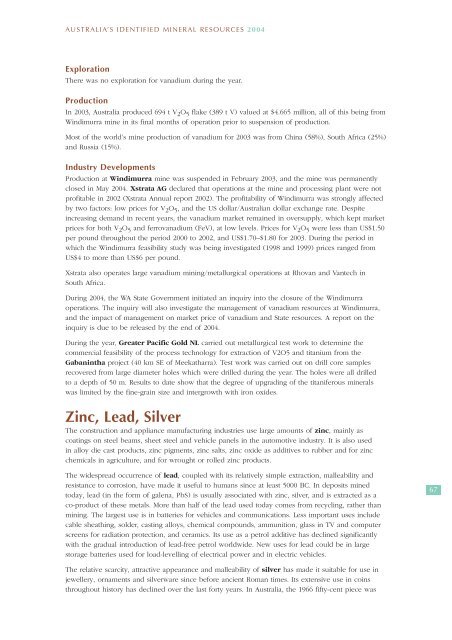australia's identified mineral resources 2004 - Geoscience Australia
australia's identified mineral resources 2004 - Geoscience Australia
australia's identified mineral resources 2004 - Geoscience Australia
You also want an ePaper? Increase the reach of your titles
YUMPU automatically turns print PDFs into web optimized ePapers that Google loves.
AUSTRALIA’S IDENTIFIED MINERAL RESOURCES <strong>2004</strong><br />
Exploration<br />
There was no exploration for vanadium during the year.<br />
Production<br />
In 2003, <strong>Australia</strong> produced 694 t V 2 O 5 flake (389 t V) valued at $4.665 million, all of this being from<br />
Windimurra mine in its final months of operation prior to suspension of production.<br />
Most of the world’s mine production of vanadium for 2003 was from China (58%), South Africa (25%)<br />
and Russia (15%).<br />
Industry Developments<br />
Production at Windimurra mine was suspended in February 2003, and the mine was permanently<br />
closed in May <strong>2004</strong>. Xstrata AG declared that operations at the mine and processing plant were not<br />
profitable in 2002 (Xstrata Annual report 2002). The profitability of Windimurra was strongly affected<br />
by two factors: low prices for V 2 O 5 , and the US dollar/<strong>Australia</strong>n dollar exchange rate. Despite<br />
increasing demand in recent years, the vanadium market remained in oversupply, which kept market<br />
prices for both V 2 O 5 and ferrovanadium (FeV), at low levels. Prices for V 2 O 5 were less than US$1.50<br />
per pound throughout the period 2000 to 2002, and US$1.70–$1.80 for 2003. During the period in<br />
which the Windimurra feasibility study was being investigated (1998 and 1999) prices ranged from<br />
US$4 to more than US$6 per pound.<br />
Xstrata also operates large vanadium mining/metallurgical operations at Rhovan and Vantech in<br />
South Africa.<br />
During <strong>2004</strong>, the WA State Government initiated an inquiry into the closure of the Windimurra<br />
operations. The inquiry will also investigate the management of vanadium <strong>resources</strong> at Windimurra,<br />
and the impact of management on market price of vanadium and State <strong>resources</strong>. A report on the<br />
inquiry is due to be released by the end of <strong>2004</strong>.<br />
During the year, Greater Pacific Gold NL carried out metallurgical test work to determine the<br />
commercial feasibility of the process technology for extraction of V2O5 and titanium from the<br />
Gabanintha project (40 km SE of Meekatharra). Test work was carried out on drill core samples<br />
recovered from large diameter holes which were drilled during the year. The holes were all drilled<br />
to a depth of 50 m. Results to date show that the degree of upgrading of the titaniferous <strong>mineral</strong>s<br />
was limited by the fine-grain size and intergrowth with iron oxides.<br />
Zinc, Lead, Silver<br />
The construction and appliance manufacturing industries use large amounts of zinc, mainly as<br />
coatings on steel beams, sheet steel and vehicle panels in the automotive industry. It is also used<br />
in alloy die cast products, zinc pigments, zinc salts, zinc oxide as additives to rubber and for zinc<br />
chemicals in agriculture, and for wrought or rolled zinc products.<br />
The widespread occurrence of lead, coupled with its relatively simple extraction, malleability and<br />
resistance to corrosion, have made it useful to humans since at least 5000 BC. In deposits mined<br />
today, lead (in the form of galena, PbS) is usually associated with zinc, silver, and is extracted as a<br />
co-product of these metals. More than half of the lead used today comes from recycling, rather than<br />
mining. The largest use is in batteries for vehicles and communications. Less important uses include<br />
cable sheathing, solder, casting alloys, chemical compounds, ammunition, glass in TV and computer<br />
screens for radiation protection, and ceramics. Its use as a petrol additive has declined significantly<br />
with the gradual introduction of lead-free petrol worldwide. New uses for lead could be in large<br />
storage batteries used for load-levelling of electrical power and in electric vehicles.<br />
67<br />
The relative scarcity, attractive appearance and malleability of silver has made it suitable for use in<br />
jewellery, ornaments and silverware since before ancient Roman times. Its extensive use in coins<br />
throughout history has declined over the last forty years. In <strong>Australia</strong>, the 1966 fifty-cent piece was

















